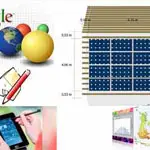Hybrid Inverters vs Battery Inverters Home Energy Storage
The two main choices available; are battery-specific inverters and so-called ‘hybrid’ or multi-mode inverters. What are the relative strengths and weaknesses of each of these types of solutions; concerning the role they play in energy storage systems?
Standard Solar PV Inverters

The basic function of a solar PV inverter is to convert the DC electricity generated by solar panels into AC electricity. Although individual products may each have their bells & whistles, without performing this integral function they cannot be called an inverter. Solar PV inverter brands are plentiful in Pakistan – Voltronic Power's Axpert, SMA, Fronius, Schneider Xantrax, INVT, ABB/Power-One, and Zeversolar are just a handful of the popular brands here.
Pros:
- Time-tested technology – used widely in grid-connected solar systems around the world
- Countless product options available
Cons:
- Possible to include battery storage, but battery side of the system will require a separate inverter
- Separate energy management system may be required to maximize overall system efficiency
Hybrid Solar Inverters

In the context of residential solar+storage systems, a hybrid inverter (sometimes referred to as a multi-mode inverter) is an inverter that can simultaneously manage inputs from both solar panels and a battery bank, charging batteries with either solar panels or the electricity grid (depending on which is more economical or preferred). Their capabilities may go beyond this, however – some devices also handle inputs from wind turbines, generators, and other power sources.
Pros:
- All-in-one inverter solution for grid-connected solar-plus-storage systems
- Frequently intelligent and programmable for maximizing overall system efficiency and savings
- Can usually be installed without batteries for future expansion
- Long history of use in off-grid and stand-alone power systems
Cons:
- Less design flexibility than modular solutions which use separate PV and battery inverters
- Generally less efficient than dedicated solar-only or battery-only inverters
Battery Inverters

Battery-specific inverters manage the charging and discharging of a battery bank. Just as with other inverters, their job is to convert DC electricity into AC electricity, but they also do the reverse – converting AC electricity into DC to charge a battery bank. Battery inverters can be installed in homes where no solar PV system exists for purposes of energy arbitration (i.e. using cheap off-peak grid electricity for battery charging), but most homes are more likely to install them to capture and store excess solar energy. Their modular nature means that they can be retrofitted relatively easily onto existing solar PV systems.
Pros:
- The modular nature lends to greater system design flexibility
- Long history of use in off-grid and stand-alone power systems means most units are exceptionally sturdy and durable
- Can be retrofitted onto existing solar PV systems for the addition of battery storage
Cons:
- Expansion of the PV system or the battery bank, may require a re-sizing of the inverter
- Minimum system size requirements
- Off-Grid inverters are the most expensive options after microinverters
Interested in energy storage for your home?
If you have interested to make your home with solar power technology, click here for Solar Quote, not only for home solar, you can send us the query of your requirement following type of solar services we deal with. These extensive services utilize a broad experience base and cover diverse roles.






